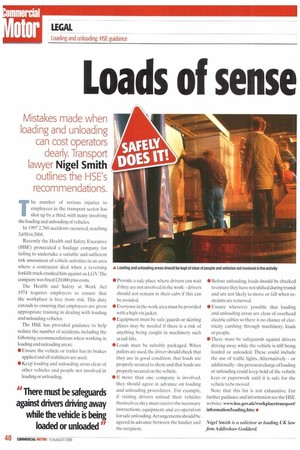Loads of sense
Page 40

If you've noticed an error in this article please click here to report it so we can fix it.
Mistakes made when loading and unloading can cost operators dearly. Transport
lawyer Nigel Smith
outlines the HSE's recommendations.
The number of serious injuries to employees in the transport sector has shot up by a third, with many involving the loading and unloading of vehicles.
In 1997 2,760 accidents occurred, reaching 3,658 in 2004.
Recently the Health and Safety Executive (HSE) prosecuted a haulage company for failing to undertake a suitable and sufficient risk assessment of vehicle activities in an area where a contractor died when a reversing forklift truck crushed him against an LG V. The company was fined £20,000 plus costs.
The Health and Safety at Work Act 1974 requires employers to ensure that the workplace is free from risk. This duty extends to ensuring that employees are given appropriate training in dealing with loading and unloading vehicles.
The HSE has provided guidance to help reduce the number of accidents, including the following recommendations when working in loading and unloading areas: • Ensure the vehicle or trailer has its brakes applied and all stabilisers are used.
• Keep loading and unloading areas clear of other vehicles and people not involved in loading or unloading. • Provide a safe place where drivers can wait if they are not involved in the work — drivers should not remain in their cabs if this can be avoided.
• Everyone in the work area must be provided with a high-vis jacket.
• Equipment must be safe; guards or skirting plates may be needed if there is a risk of anything being caught in machinery such as tail-lifts.
• Loads must he suitably packaged. When pallets are used, the driver should check that they are in good condition, that loads are properly secured to them and that loads are properly secured on the vehicle.
• If more than one company is involved, they should agree in advance on loading and unloading procedures. For example, if visiting drivers unload their vehicles themselves, they must receive the necessary instructions, equipment and co-operation for safe unloading.Arrangements should be agreed in advance between the haulier and the recipient. • Before unloading, loads should be checked to ensure they have not shifted during transit and are not likely to move or fall when restraints are removed.
• Ensure wherever possible that loading and unloading areas are clear of overhead electric cables so there is no chance of electricity earthing through machinery, loads or people.
• There must be safeguards against drivers driving away while the vehicle is still being loaded or unloaded. These could include the use of traffic lights. Alternatively — or additionally—the person in charge of loading or unloading could keep hold of the vehicle keys or paperwork until it is safe for the vehicle to be moved.
Note that this list is not exhaustive. For further guidance and information see the HSE website: www.hse.gov.uk/workplacetransport/ information/loading.htm •




























































































































































































